the largest estate jeweler in New England | 6 locations | 5 Days a week live shopping on instagram
the largest estate jeweler in New England | 6 locations | 5 Days a week live shopping on instagram
the largest estate jeweler in New England | 6 locations | 5 Days a week live shopping on instagram
the largest estate jeweler in New England | 6 locations | 5 Days a week live shopping on instagram
Add description, images, menus and links to your mega menu
A column with no settings can be used as a spacer
Link to your collections, sales and even external links
Add up to five columns
Add description, images, menus and links to your mega menu
A column with no settings can be used as a spacer
Link to your collections, sales and even external links
Add up to five columns
June 12, 2019 10 min read
In a world of mass manufactured jewelry, people are craving special, one-of-a-kind engagement rings that they feel a connection to. Vintage engagement rings have a soul to them that new mass-produced rings simply can’t compare to. Antique and vintage rings have been hand-finished, giving them that indefinable quality that sets them apart. This artistry, in addition to being beautiful, makes each piece unique, so you can be sure of having an engagement ring that draws the eyes and envy of your friends.
Another important benefit to choosing a vintage engagement ring over a modern one is its low environmental impact. Mining precious metals and diamonds to manufacture new jewelry takes its toll on the earth, so by purchasing vintage and antique jewelry, you are doing your part to reduce the demand of such practices. In addition to recycling precious metals and restoring vintage and antique jewelry, Market Square Jewelers only sources diamonds from estates, so our environmental impact is low.
Beyond the environmental benefits, antique and vintage engagement rings are made to last. The old adage “they don’t make them like they used to” applies to jewelry, as well. From Victorian Belcher settings, to Art Deco die-stamped filigree, to Retro illusion head settings, vintage engagement rings are cleverly designed to be both beautiful and functional. With care and simple restoration, your engagement ring can last another hundred years.
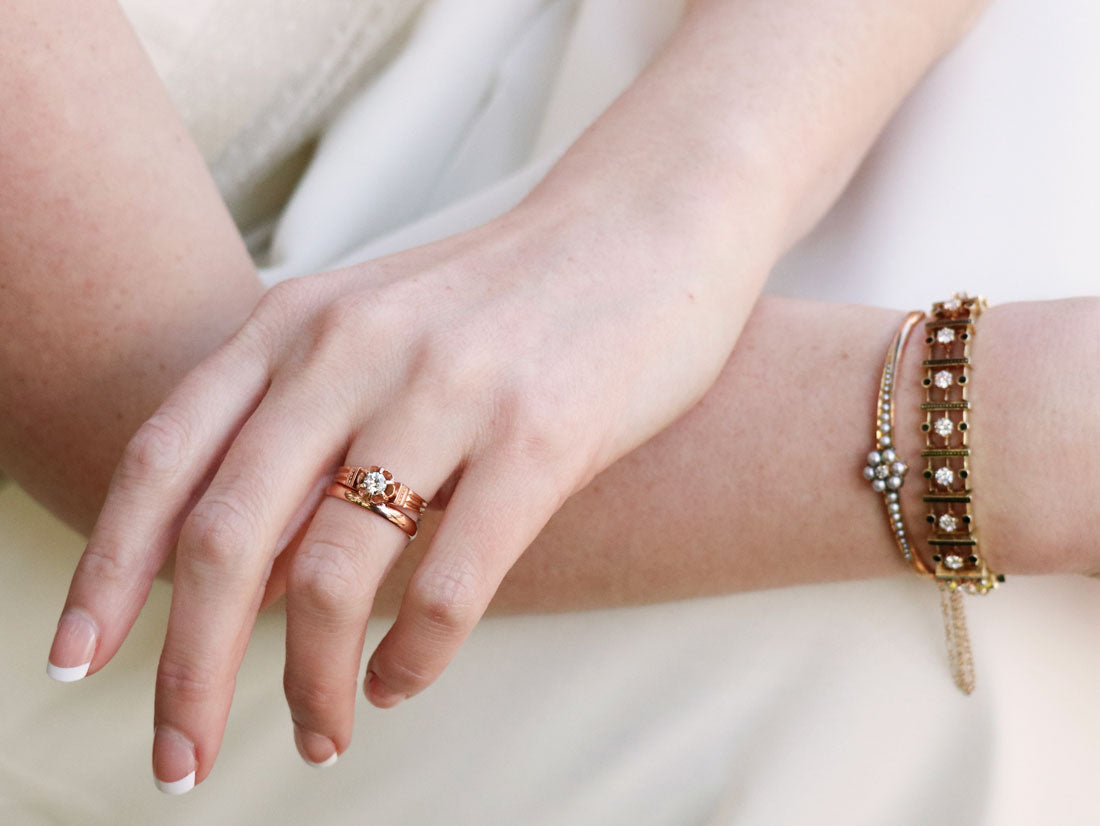
Layer Victorian Era jewelry for a modern bohemian interpretation of classic bridal pieces.
In recent years, diamond engagement rings have made way for an explosion in popularity of gemstone engagement rings. Though there are no “rules” about which gem you should choose for your engagement ring, there are some important factors to consider.
When sifting though the wide selection of beautiful gems, you can narrow down your search by asking yourself a couple of questions:
If you plan on wearing your engagement ring every day, you should choose a harder gemstone that can withstand the occasional knocks that can occur. If you work with your hands, you should also choose a harder gemstone.
There is a reason beyond beauty that diamond engagement rings are so popular – diamonds are the hardest, and therefore most durable, gemstone. If you want to wear your engagement ring every day, diamonds are the best choice to ensure durability.
Related Article: How to Shop For Diamonds Using the Four C's
If you prefer colored gemstones, sapphires and rubies (both of the same mineral, corundum) are also a good choice for durability. Sapphires are particularly versatile, as they are available in almost every color of the rainbow. Purples and pinks are popular colors for sapphire engagement rings, but you can also find the gem in orange, yellow, and bluish green.
Related Article: Quality Characteristics and Value of Sapphire
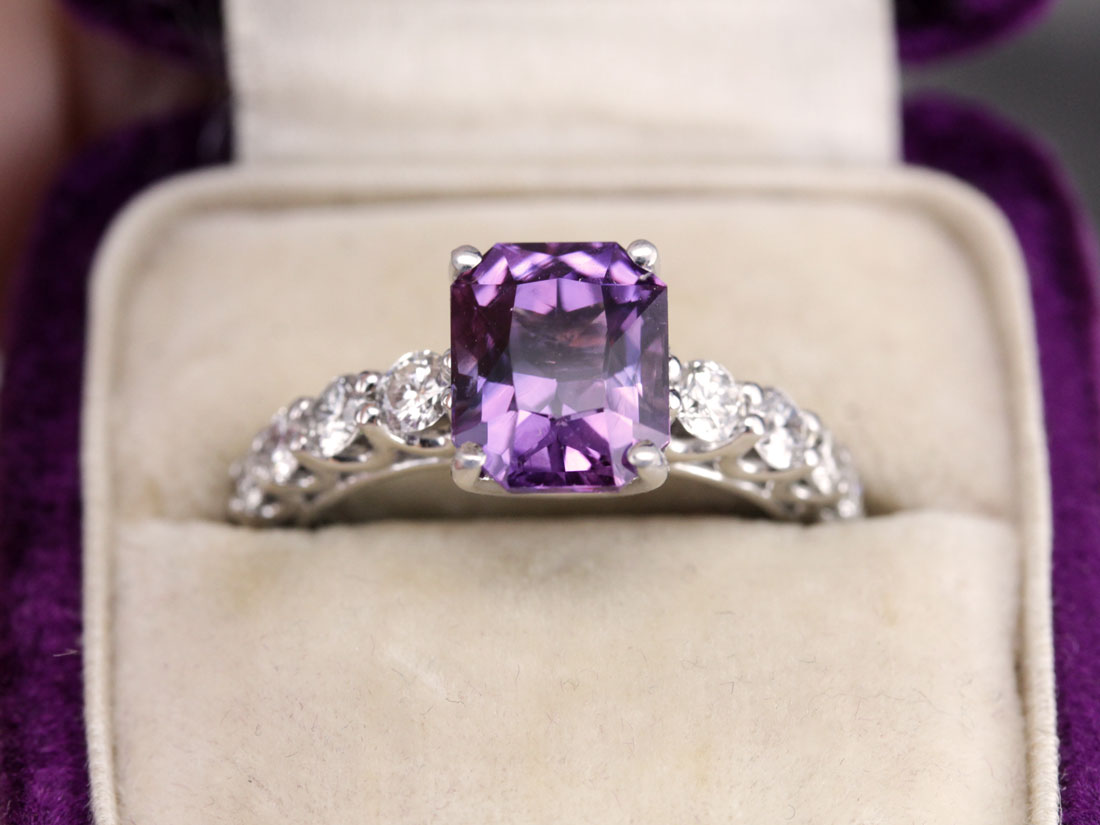
Sapphire engagement rings come in a wide range of colors and are more durable than other gemstones.
When considering alternative gemstone engagement rings, you can use the Mohs hardness scale to help determine their durability. Each gem has been assigned a number on the scale that corresponds with its hardness in relation to other gems. A diamond is the hardest at a ten, while sapphires and rubies are at a nine. An important thing to be aware of is that hardness can vary greatly from number to number. For example, sapphires (9) are twice as hard as emeralds (8), however diamonds (10) are four times as hard as sapphires.
Here is a list of gemstones that have become popular for engagement rings and where they fall on the Mohs hardness scale:
If you are careful with your engagement ring, or don’t wear it everyday, you can expand the possibilities for the gemstone you choose.
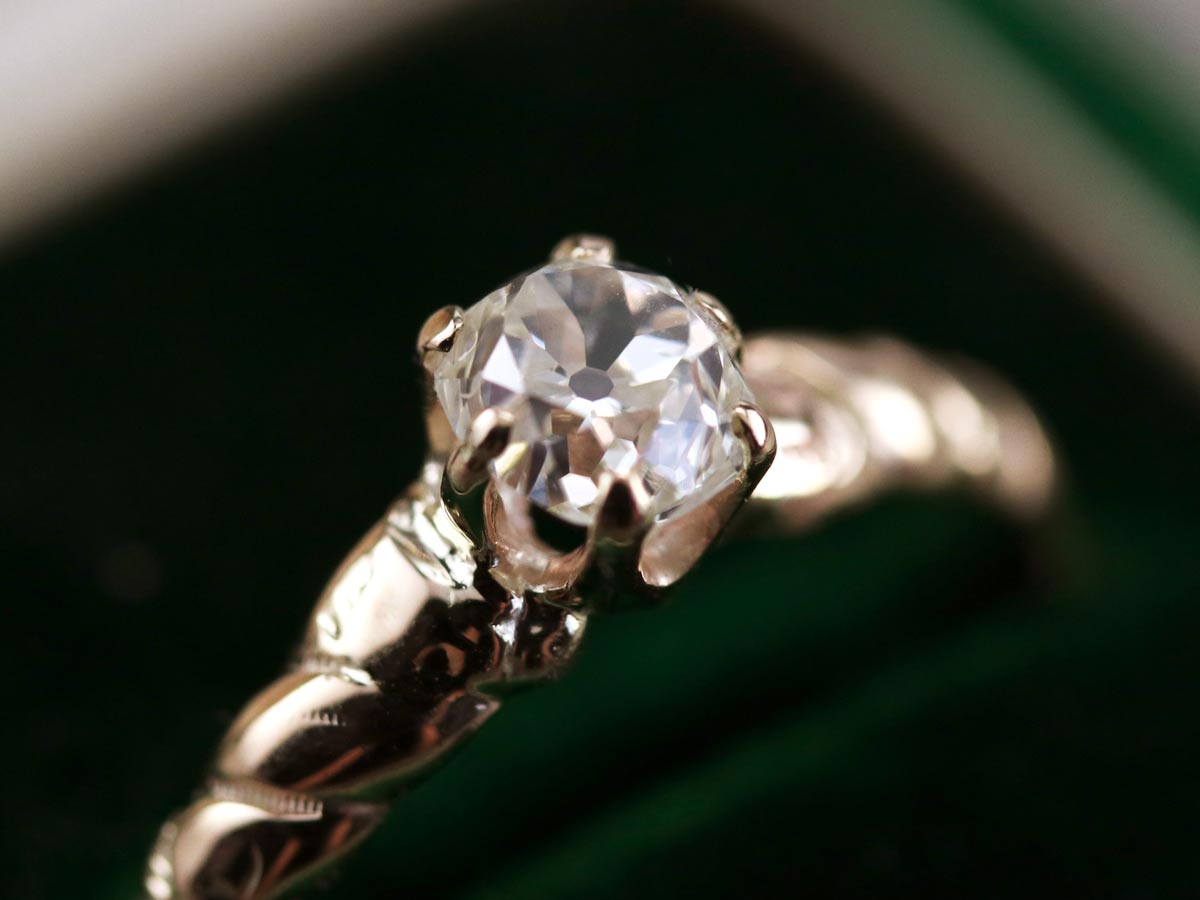
This antique engagement ring is set with an Old Mine cut diamond.
If you’ve only shopped in modern jewelry stores, you might think that one diamond is just like any other. The joy of shopping for antique engagement rings is discovering the uniqueness of each diamond. Before the rapid modernization of the 20th century, the craft of diamond cutting was not about mass production, where the goal is to eliminate variance. It was in individual approach that resulted in one-of-a-kind works of art. When you look at an antique diamond, you think about its history, about the physical hand of the gem cutter, in a way that you don’t when you look at a modern brilliant cut.
If you've ever seen an antique diamond, you know it sparkles in a way that modern cuts can't compare to. These old diamonds were cut by lamp light, and thus they sparkle beautifully in many different lighting conditions. Is there anything more romantic than a diamond glittering in the candlelight? When shopping for antique diamonds, try looking at them in both artificial and natural light if you can – you'll get a whole new perspective.
The most well-known antique cuts, Old Mine and European, have a lot to offer in terms of beauty and design. To learn more about the characteristics of these two cuts, read our blog post.
Related Article: Old Mine Cut Diamonds: What They Are & Why We Love Them

These gold wedding bands illustrate three different karat weights.
Choosing the right metal for your engagement ring can often be the easiest part of the process, as most people know which metals they prefer. People with cooler undertones in their skin tend to be complimented by white gold and platinum, while people with warmer skin tones tend to look nice with yellow gold. If you have pink undertones, you may prefer rose gold, while people with olive undertones look beautiful next to green gold.
Of course, there are no “rules” when it comes to choosing metals, and you should try on lots of different kinds to find your favorite. Antique metals are special in that they flatter a wide variety of skin tones. Victorian rose gold, for example, looks beautiful on both dark skin with warm undertones, as well as pale skin with cool undertones.
Another thing to think about when dealing with gold is the karat weight. Lower karats (such as 10K) have less gold in the metal alloy, but tend to be more affordable and durable. Higher karats (such as 18K) have a higher ratio of gold in the alloy, but are softer and more expensive. 14K gold is a great middle ground between the two, which is why it is so popular in jewelry. However, don’t be afraid to go above or below that benchmark. For those who want a rich, luxurious looking gold, 18K is perfect for you. For those who are on a budget, 10K will deliver the gold you want at a lower price point.
Related Article: The Evolution of Rose Gold Jewelry
Related Article: A Beginner's Guide to Gold Jewelry
Each era of engagement ring has its own distinct style and beauty. Whether you prefer bolder high profile rings, or more delicate designs with sweet details, there is a vintage style for you. Here are some popular eras and their engagement ring styles:
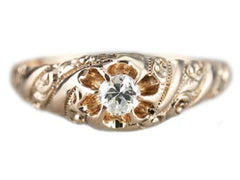
The Victorian era was all about sentimentality and romance. Victorian engagement rings tend to be either solitaire or halo designs. Buttercup and Belcher settings are popular, and serve the dual purpose of protecting the center stone, as well as being beautiful. Floral motifs and chased details typically adorn the shoulders of the ring, though you can also find elegant minimalist styles as well. We love Victorian engagement rings for their easy to wear low profiles and the rosy warmth of the gold, which flatters most skin tones.
Shop Victorian engagement rings
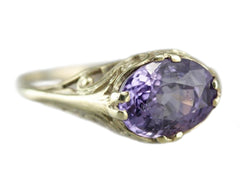
The Art Nouveau era was inspired by the natural world and the female form. Art Nouveau engagement rings feature floral and wheat motifs and elongated designs. Green gold was popular, and was often paired with a platinum head to showcase the diamond. We love Art Nouveau engagement rings for their extraordinary details and hand-finished accents.
Shop Art Nouveau engagement rings
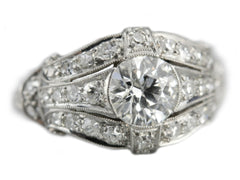
Opulence and stateliness defined the Edwardian era. Edwardian engagement rings are all about the diamonds, set into platinum to create a dazzling display. Milgrain edging and pavé settings bring diamonds to the forefront and enhance their sparkle. We love Edwardian engagement rings for their bold, show-stopping style.
Shop Edwardian engagement rings

The Art Deco era shrugged off feminine style in favor of more masculine, architectural looks. Art Deco engagement rings are all about the filigree. Die-stamping techniques allowed for intricate, delicate looking designs that were actually quite strong. This filigree is both beautiful and functional, because it allows lots of light to flow into the center gem. White gold was popular, and beautifully compliments diamonds. We love Art Deco engagement rings for their undeniable stylishness and marriage of beauty and function.
Shop Art Deco engagement rings
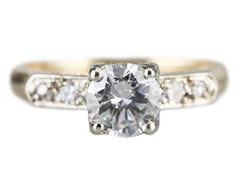
The Retro era spans a variety of styles, but in essence it was about timelessness over trendiness. Retro engagement rings are perfect for the gal with a classic style. Illusion head settings, two tone gold, and simply accented shoulders are all hallmarks of Retro engagement rings. These designs will never go out of style and will stay elegant for generations. We love Retro engagement rings for their effortless chic and ability to pair with almost any wedding band.
Related Article: Engagement Ring Settings You Should Know
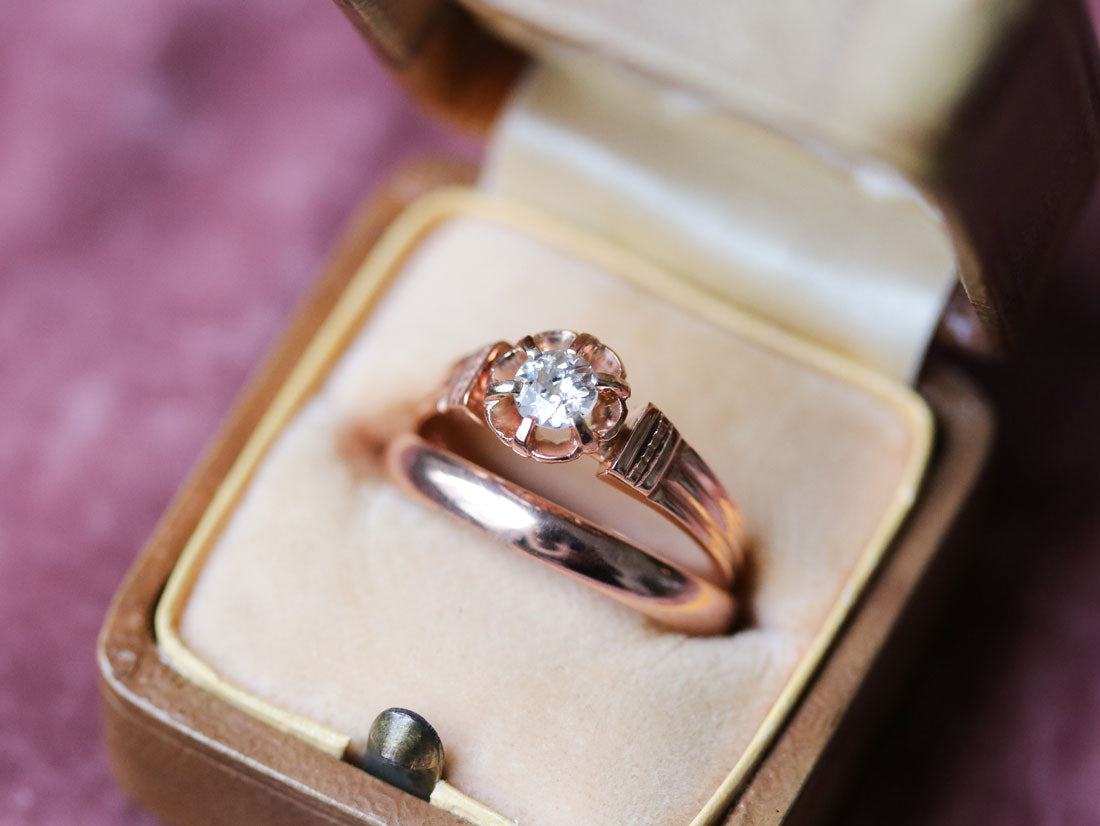
A Victorian diamond rose gold engagement ring paired with a wedding band from the same era.
Once you have a vintage engagement ring, you’ll want a wedding band that compliments it. The easiest way to match your wedding ring to your engagement ring is to choose one from the same era. Here is a quick reference for the styles of bands that were common in each era.
There is also a lot of fun to be had in mixing and matching pieces from different eras. A newer diamond eternity band might be the perfect compliment to an Art Deco diamond filigree solitaire. If however, you are looking for an authentic vintage design with a little more control over customization, a reproduction style might be perfect for you.
Our Elizabeth Henry line features antique and vintage designs reproduced from their original master models. This means you can find the perfect wedding band to match your vintage engagement ring, choosing the metal, size, and style yourself. Whether you want the band to curve to sit flush with your engagement ring, or diamonds set into the floral pattern, we offer a full range of customizations to create the wedding set of your dreams. Contact us to start the customization process!
Related Article: Diamond Wedding Band Settings: Which One Is Right For You
Shop vintage diamond wedding bands
Shop vintage plain and patterned wedding bands

This floral engagement ring combo (the Greenleaf ring and Marjorie band) is from the Elizabeth Henry line, cast from master models from the Art Deco era.
Once you’ve selected the perfect vintage engagement ring, you’ll want to keep it looking it’s best. Vintage engagement rings don’t necessarily require extra maintenance compared to modern engagement rings, but there are a few things you’ll want to keep in mind to ensure your ring lasts a long time.
Perhaps the most important thing to keep an eye on is the security of the main stone. Prongs can wear and shift over time, and the gem they hold may become loose or even fall out. An easy way to check the security of your gem is to gently shake your ring close to your ear. If you hear any kind of rattling sound, the gem may be loose and you should take your ring to your local jeweler to have it checked.
You can also inspect the prongs visually to see if they have worn down. A method called retipping is used to build up the prongs and re-secure the gemstone. Retipping is a very common jewelry repair service and is a great preventative step to avoid lost gemstones.
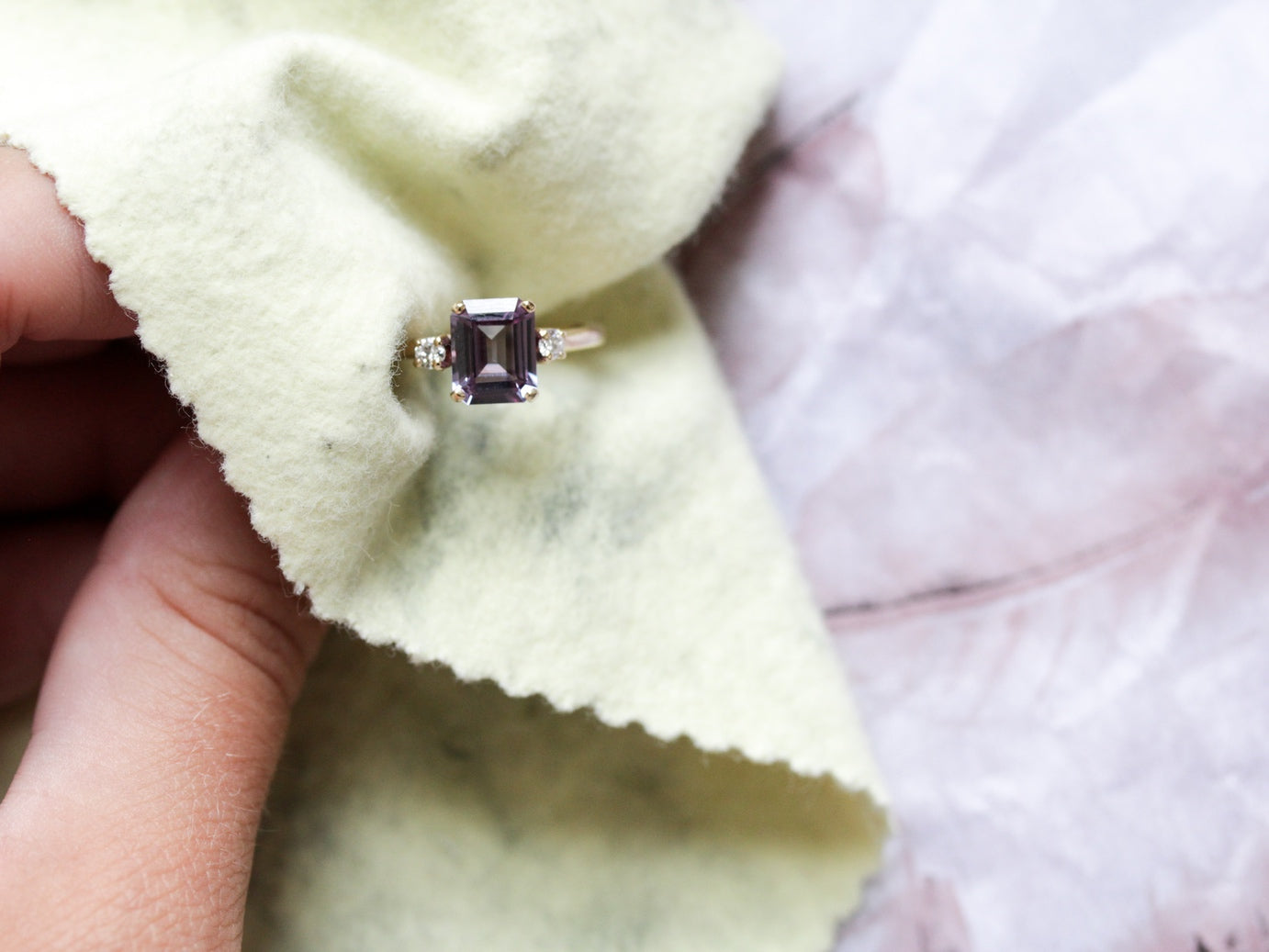
With diamond engagement rings, you may notice that the diamonds lose some of their sparkle and shine over time. This is simply the everyday dirt and oils that your ring comes into contact with during wear. For regular maintenance at home, you can clean your diamond engagement ring with a soft toothbrush and soapy water (use mild dish soap).
For a more professional clean, ultrasonic cleaners will do a thorough and effective job of removing grease and dirt. Ultrasonic cleaners work by sending low frequency sound waves through a cleaning solution, causing that solution to vibrate around the ring. We recommend bringing your diamond ring to a professional for ultrasonic cleaning, as certain fracture-filled diamonds or damaged settings may not be suitable for this type of intensive cleaning, and it is best to get the opinion of a jewelry professional. At Market Square Jewelers, we provide ultrasonic cleaning as a walk-in service, and are happy to advise you on the best way to maintain your particular ring.
With gemstone engagement rings, gentle hand cleaning is the best method. Carefully brush away dirt and grime with a soft toothbrush and mild soapy water. Be sure to let your ring dry completely before storing. Note that some gemstones are very sensitive to moisture, light, and heat and may need certain considerations when cleaning. Read our blog post on jewelry care to learn more about how to care for particular gemstones, and visit your local jewelry professional if you have any hesitancy about how to clean your engagement ring.
Related Article: The Summer Jewelry Care Handbook
Taking preventative steps with the maintenance of your engagement ring can save you money down the road. Take your ring to a trusted jewelry professional at least twice a year to have it assessed for damage. A trained eye can foresee potential problems and recommend small repairs that could prevent more costly damage in the future.
Related Article: How Can I Find Out Her Engagement Ring Size?
September 17, 2021 2 min read
July 26, 2021 4 min read
June 29, 2021 9 min read
Get 10% off your next purchase!

Get 10% off when you sign up for our newsletter!